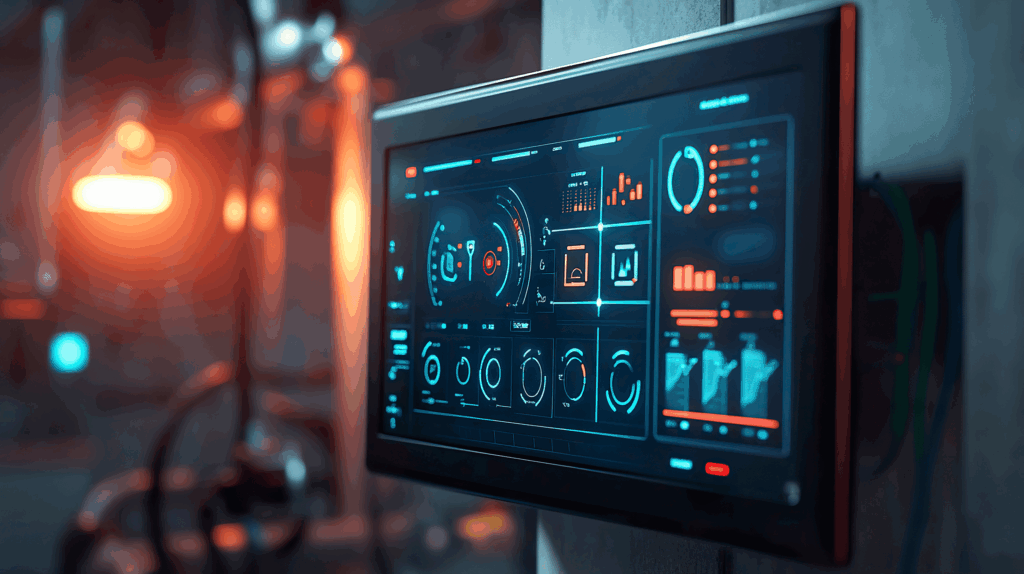Cloud-Based Maintenance Management: Benefits and Implementation
How enterprises transition from on-premise systems to cloud CMMS platforms — improving uptime, scalability, and security while enabling mobile-first maintenance operations.

TL;DR
The shift to cloud maintenance software is transforming how organizations plan, track, and execute maintenance. SaaS maintenance solutions eliminate local infrastructure limits, offer faster updates, and improve cross-site collaboration through real-time data. This article explores migration strategies, data protection, and the operational advantages of mobile CMMS platforms.
Highlights
- Scalability and speed — cloud CMMS platforms deploy faster and scale globally without local IT burden
- Data protection — built-in redundancy, encryption, and role-based access make SaaS maintenance secure and compliant
- Mobile flexibility — mobile CMMS tools connect field teams with instant access to assets, work orders, and analytics anywhere
Introduction
When Coca-Cola Hellenic Bottling Company moved its maintenance operations to a cloud CMMS platform, the shift wasn’t just about technology — it was about speed. The company replaced 14 on-premise systems across 28 countries with a single SaaS maintenance solution accessible to every technician from a tablet. Within six months, work order completion time dropped by 32%, and preventive maintenance compliance rose from 68% to 95%.
Across industries, the migration to cloud maintenance software has become a strategic priority. Gartner’s 2026 IT infrastructure forecast estimates that over 70% of CMMS deployments will be SaaS-based, driven by scalability, lower IT costs, and global accessibility. However, many organizations still hesitate due to security concerns, legacy integrations, and uncertainty about ROI.
The question has shifted from “Should we move to the cloud?” to “How do we migrate safely and prove value quickly?”
This article explores the tangible benefits of cloud-based maintenance, data protection mechanisms, and the practical roadmap for transitioning from on-premise systems to mobile CMMS platforms — without losing visibility, control, or compliance.
The Limits of On-Premise CMMS
For more than two decades, industrial companies have relied on on-premise maintenance systems to manage assets, track work orders, and store maintenance history. While effective in isolated plants, these setups are now reaching their limits in a distributed, data-driven world.
The first barrier is infrastructure rigidity. Each site must host, update, and secure its own CMMS instance. A simple version upgrade can take months of coordination between IT, vendors, and maintenance teams — delaying innovation. Many organizations report 15–20% higher total cost of ownership for on-premise systems compared with SaaS maintenance models.
The second challenge is data fragmentation. Multi-site companies struggle to consolidate metrics like downtime, cost per work order, or spare parts usage across different servers. Without centralized visibility, benchmarking reliability or ROI becomes impossible.
Finally, there’s limited mobility. Field technicians can’t access work orders or update asset data in real time, creating delays and data errors. In an era where operations depend on agility, legacy software locks critical maintenance data behind firewalls and outdated hardware.
The result: slower decisions, higher costs, and missed opportunities for predictive maintenance and analytics. The shift to cloud CMMS isn’t just modernization — it’s operational necessity.
Building a Cloud-Ready Maintenance Ecosystem
Transitioning to cloud CMMS is not only about replacing infrastructure — it’s about creating an integrated maintenance environment that supports real-time collaboration, analytics, and scalability. Successful migrations follow five core principles that combine technology with process discipline.
1.Adopt a SaaS-First Strategy
Choose cloud maintenance software with modular architecture, open APIs, and secure multi-tenant hosting. Modern SaaS maintenance platforms offer automatic updates, elastic scalability, and predictable subscription-based costs — reducing IT workload by up to 40%.
2.Ensure Data Continuity
Before migration, define clear data governance standards: asset hierarchies, work order types, and user permissions. Cleanse and normalize legacy data to prevent inconsistencies once moved to the cloud.
3.Integrate with Existing Systems
A cloud CMMS must connect seamlessly with ERP, IoT, and procurement systems. API-based integration enables synchronized financials, spare parts availability, and maintenance schedules — eliminating double data entry.
4.Enable Mobile Operations
Deploy mobile CMMS applications that allow technicians to receive work orders, log maintenance notes, and upload photos directly from the field. This improves accuracy and boosts productivity by 25–35%.
5.Embed Security and Compliance
Implement role-based access, encryption in transit and at rest, and regional data residency to meet ISO 27001 or SOC 2 compliance. Cloud-native security is now stronger and more auditable than legacy on-prem setups.
When aligned with business objectives, these pillars turn cloud migration from a technical upgrade into a strategic accelerator of reliability and efficiency.
Watch: Computerized Maintenance Management Workshop CMMS provides a deep dive into CMMS implementation, including predictive maintenance, customization support, and dashboard configuration.
On-Premise vs Cloud CMMS
While traditional on-premise systems give full local control, their maintenance, upgrade, and integration costs often outweigh the benefits. In contrast, cloud CMMS and SaaS maintenance platforms deliver agility, scalability, and long-term cost efficiency — without compromising data security or performance.
| Aspect | On-Premise CMMS | Cloud CMMS (SaaS) | Key Advantage |
| Deployment | Requires local servers and IT setup | Browser-based, ready in weeks | Faster time to value |
| Scalability | Limited to hardware capacity | Elastic, global scalability | Expansion without extra infrastructure |
| Maintenance & Updates | Manual upgrades, high IT effort | Automatic updates managed by vendor | Always up to date |
| Cost Structure | Capital expenditure (CAPEX) | Operational expenditure (OPEX) | Lower upfront investment |
| Mobility | Desktop-only, local access | Mobile CMMS apps and web access | Real-time collaboration |
| Security & Compliance | Depends on local policy | Centralized encryption, ISO/SOC certifications | Higher resilience and visibility |
Organizations switching to cloud maintenance software report up to 30% lower total cost of ownership (TCO) and 40% faster feature adoption compared with legacy deployments — proof that agility now outweighs physical control.
Real Implementation Case
Schneider Electric: Migrating Global Maintenance to the Cloud

Challenge:Schneider Electric managed maintenance for more than 200 production facilities worldwide, each running localized on-premise CMMS instances. The result: inconsistent data, long upgrade cycles, and limited reporting visibility. IT maintenance consumed 28% of annual CMMS costs, and version discrepancies made integration with ERP nearly impossible.
Approach: The company migrated EAM to a scalable cloud platform, unifying data for 3,000 users. Legacy structures were standardized, ISO 27001 compliance ensured cybersecurity, and mobile CMMS apps deployed to technicians.


Results:
Deployment time: reduced from 6 months to 6 weeks per site
Maintenance cost savings: 24% in the first year
Work order closure time: improved by 31%
Data security incidents: 0 since migration
ROI: achieved in 14 months
Key lesson: Invest in data integrity and user training before automating — Schneider’s approach modernized its entire maintenance culture, demonstrating that cloud CMMS can achieve both agility and robust enterprise security.

From On-Premise to Cloud CMMS
Migrating from on-premise to cloud maintenance software requires a structured, secure, and business-aligned process. The roadmap below outlines a proven five-phase approach used by global enterprises to minimize risk and accelerate adoption.
| Phase | Objective | Key Activities | Deliverables |
| 1. Assessment & Planning | Evaluate readiness and define ROI targets | Audit current CMMS setup, infrastructure, and data quality. Identify dependencies and integration requirements. | Migration strategy, cost-benefit analysis |
| 2. Data Preparation | Ensure accuracy and structure | Cleanse legacy data, normalize hierarchies, and validate maintenance records. | Unified data model, migration templates |
| 3. Platform Configuration | Set up cloud CMMS and integrations | Configure user roles, connect ERP/IoT systems via APIs, and enable SSO authentication. | Secure, functional SaaS environment |
| 4. Pilot & User Training | Test adoption and validate performance | Launch pilot in one facility; train maintenance and IT teams on mobile CMMS workflows. | Pilot report, training outcomes |
| 5. Full Migration & Optimization | Scale and measure | Deploy enterprise-wide, implement analytics dashboards, and monitor KPI trends. | Live system, continuous improvement plan |
Organizations following this phased approach typically achieve 20–30% faster rollout, higher data reliability, and measurable uptime gains within the first operational year.
The move to the cloud isn’t just about infrastructure — it’s about turning maintenance into an intelligent, connected service.
— Satya Nadella, CEO, Microsoft
Pitfalls and Best Practices
Moving maintenance operations to the cloud can accelerate efficiency — but only when execution is structured and disciplined. Below are the most common pitfalls enterprises encounter, and the proven strategies to prevent them.
1. Underestimating Data Quality
- Pitfall: Migrating duplicate or incomplete asset records leads to inaccurate KPIs.
- Best Practice: Conduct a data cleansing phase before migration. Validate master data and align asset hierarchies across all facilities.
2. Neglecting Security Ownership
- Pitfall: Assuming security is entirely the vendor’s responsibility.
- Best Practice: Establish shared accountability. Review compliance standards (ISO 27001, SOC 2), enforce role-based permissions, and perform regular audits.
3. Limited User Adoption
- Pitfall: Teams resist new workflows or mobile tools.
- Best Practice: Implement hands-on training early in the pilot phase. Provide mobile devices and clear ROI metrics that connect adoption to daily productivity.
4. Overcustomization
- Pitfall: Excessive feature tailoring complicates updates and raises vendor dependency.
- Best Practice: Follow a “configure, don’t customize” rule. Use modular extensions only for mission-critical needs.
5. Ignoring Integration Depth
- Pitfall: Treating cloud CMMS as a standalone solution, disconnected from ERP or IoT data.
- Best Practice: Design API-driven interoperability between maintenance, procurement, and performance analytics from day one.
A successful SaaS maintenance deployment balances speed with governance — blending agility, user trust, and robust security into a sustainable maintenance ecosystem.
Key Insights
- Cloud-first is now business-critical. Cloud maintenance software delivers scalability, continuous updates, and reduced IT dependency — accelerating enterprise-wide reliability gains.
- Security and governance come first. A strong compliance framework and shared responsibility model ensure that SaaS maintenance environments remain trusted, auditable, and resilient.
- Mobility drives adoption. Empowering technicians with mobile CMMS tools shortens feedback loops, improves data accuracy, and turns maintenance from reactive to proactive.
Together, these pillars transform cloud CMMS from a cost-saving IT decision into a strategic enabler — creating real-time visibility, faster ROI, and a foundation for predictive maintenance and asset intelligence.
How to Choose a Web Development Company in the USA — and Why the Market Is Evolving Faster Than Ever
Partner with a web provider able to execute secure cloud migrations, implement multi‑tenant maintenance solutions, and maintain data protection standards.
Enterprise Asset Management (EAM): Implementation Strategies
Learn how to select, integrate, and scale EAM platforms across global operations while aligning maintenance, finance, and ERP systems.
Industrial IoT Sensors: Complete Guide to Smart Maintenance Infrastructure
Explore how sensor networks and edge analytics enable real-time monitoring, predictive insights, and cloud-integrated maintenance workflows.
Conclusion
The evolution from on-premise to cloud CMMS marks one of the most significant shifts in modern maintenance strategy. What was once an IT upgrade has become a competitive necessity — delivering agility, transparency, and global scalability.
Organizations that successfully adopt cloud maintenance software report measurable results: up to 30% lower total cost of ownership, 25–40% faster work order execution, and improved collaboration across maintenance, operations, and IT. Beyond cost, the cloud enables standardization — every facility, technician, and asset connected through a single digital framework.
The next stage of SaaS maintenance will push even further. Integration with IoT data, predictive algorithms, and AI-driven scheduling will turn maintenance platforms into self-optimizing ecosystems. Mobility and security will continue to evolve side by side — ensuring that data remains accessible everywhere, yet protected always.
The question for 2026 isn’t whether the cloud is ready for maintenance. It’s whether your organization is ready to operate at the speed and intelligence that mobile CMMS platforms now make possible.